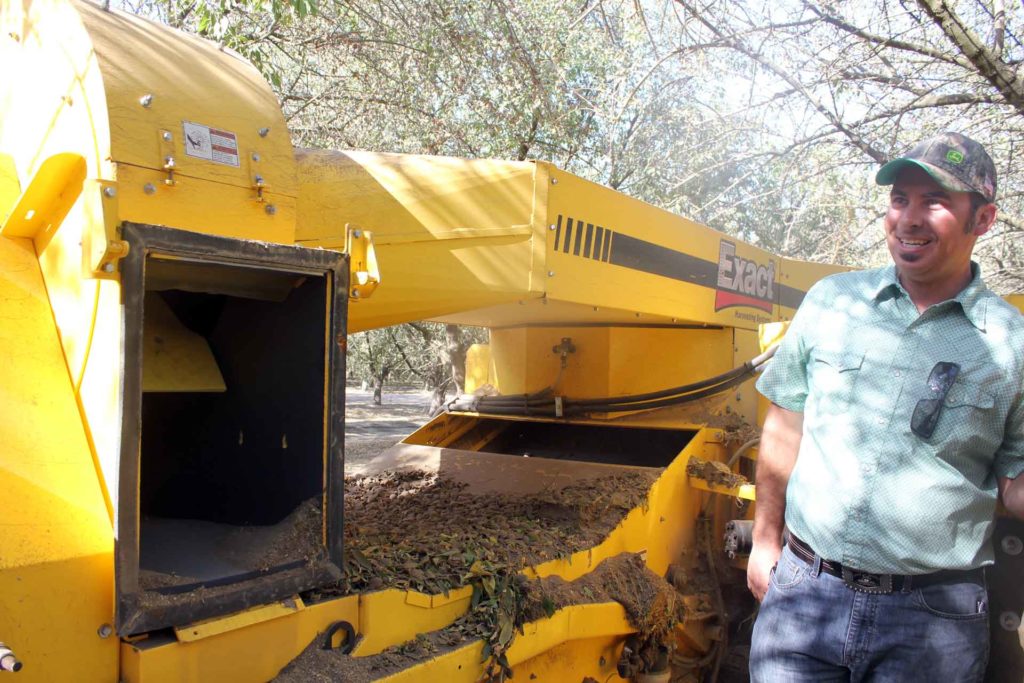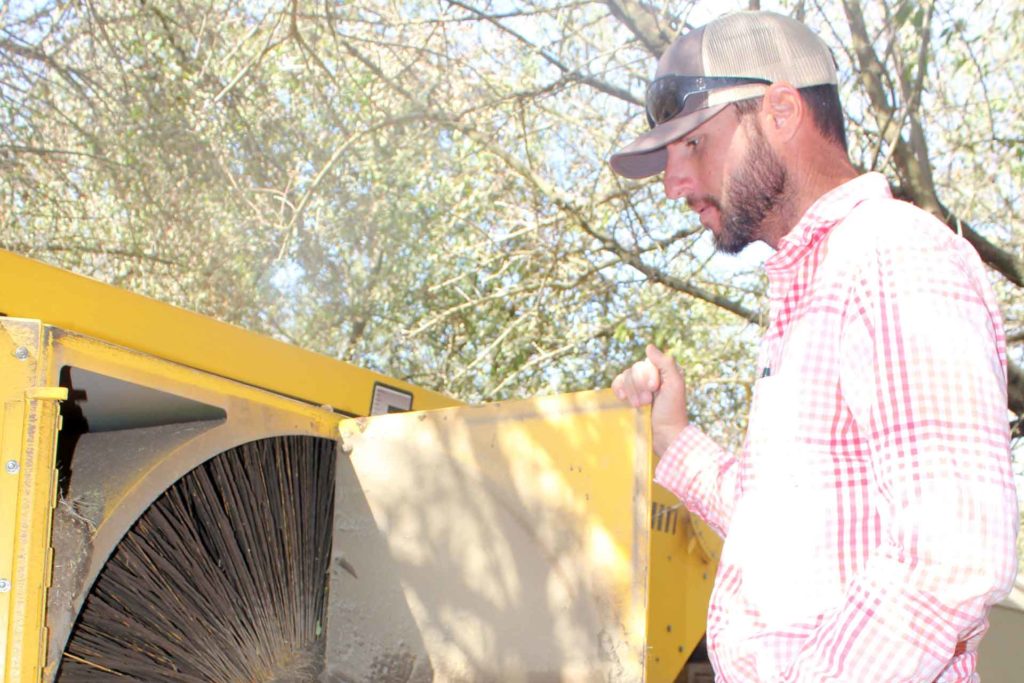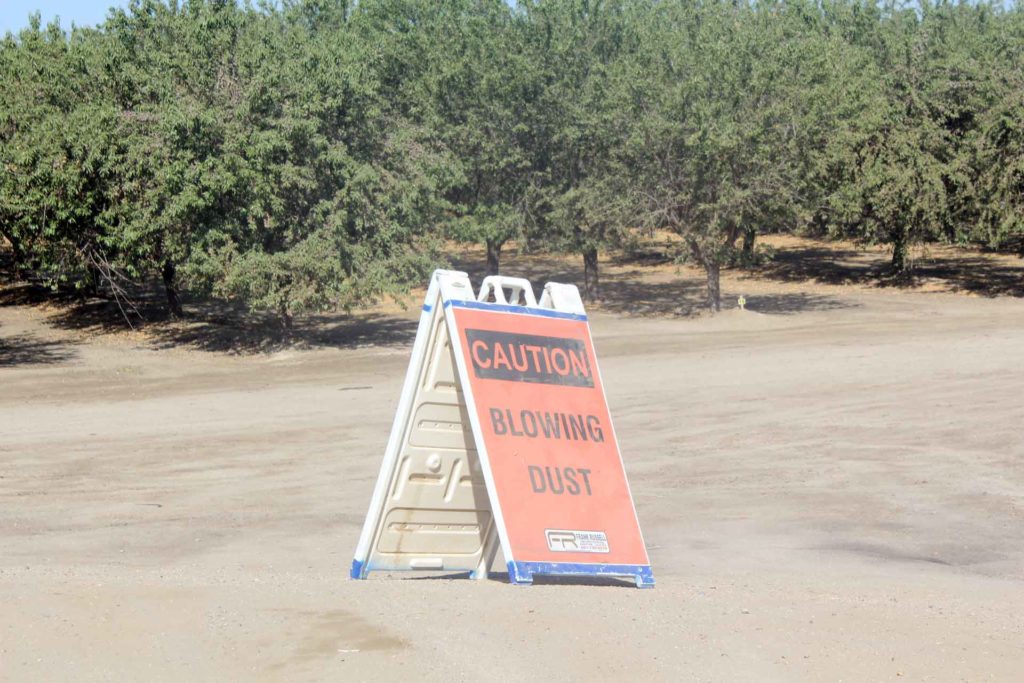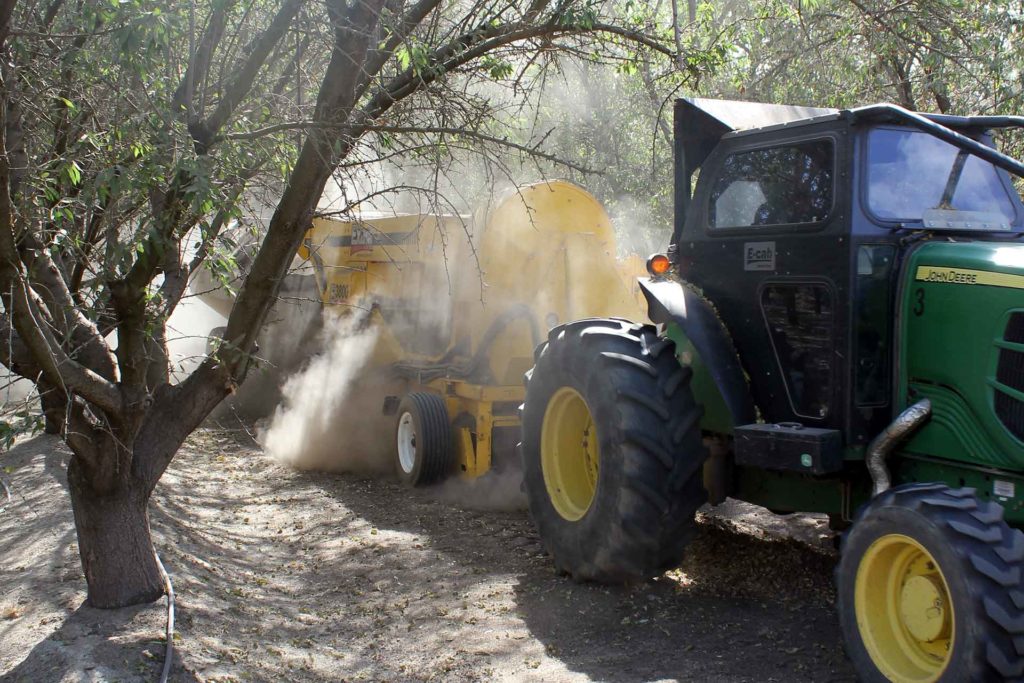A clear view to the very end of a row of trees, just a few rows away from operating harvest equipment, showed how seriously California’s almond growers are taking their industry’s efforts to reduce dust.
Dust Reduction Goals
Purchase of harvest equipment designed to generate less dust, harvest strategies to reduce dust and grower efforts to minimize dust in sensitive areas are all attempts by almond growers to meet 2025 dust reduction goals sought by Almond Board of California (ABC). The goal, set in 2018, is to reduce total harvest dust by 50 percent.
Air quality, particularly during late summer, can be negatively impacted by dust generated during almond harvest. Sweepers and pick up machines operating in orchards can create significant amounts of dust and contribute to high levels of particulate matter in the air. To address this issue, Almond Board of California has funded research over the last ten years to develop a number of methods growers can implement on their operations to reduce the amount of dust generated and improve air quality during harvest. The San Joaquin Valley Air Resources Control Board and Natural Resources Conservation Service have also offered incentive programs to help growers with the purchase of equipment designed for dust reduction.
Sebastian Saa, Senior Manager of Agricultural Affairs at The Almond Board said,
“Our industry has made great strides in reducing dust over the years. While this progress is important, though, we’re even more excited about what’s to come as we invest in research to propel us to the next level and help the industry achieve the Almond Orchard 2025 Goal to reduce dust during harvest by 50%.”
Dust Reduction Machinery
One almond grower taking advantage of ABC’s research is Samuel Ghilarducci of Shafter. As the end of his Nonpareil harvest approached in early September, he watched as the pickup machine made passes through the orchard. The sandy ground in that orchard makes dust reduction more difficult, he said, but machinery designed to reduce dust combined with smooth, clean orchard floors does make a difference in the amount of dust generated.
“We normally couldn’t be this close to the machinery when it’s running, no closer than eight to ten rows. There is dust, but it’s not spread out like it could be,” Ghilarducci said. This was his second harvest with a pick up machine designed to reduce dust generation. He estimated that dust coming from his orchard harvester during harvest was reduced by 70 percent.
The harvest dust levels would be much higher, he said, but the pick up machine, an Exact Corp 3800, picking up his windrowed almonds, has a moisture injection system and a wafer brush drum to scrub the fine dust particles from the air stream before it is released from the machine.
“This is what we have instead of dust,” Ghilarducci said, picking up small mud balls from the ground after the machine passed by. “The brushes act like a sponge and catch the dust.”
The Exact machine carries a 120-gallon water tank that empties in about three and a half hours depending on the soil type in the orchard and age of the trees.
Trent Goehring of Kern Machinery said the machine operator could adjust the pressure on the pump to match field conditions. The operator’s skill can also make a difference. If the pickup head is set too low, more dirt will enter the machine. As the nuts are moved along the cleaning belt, twin rods drop excess dirt, keeping it from going into the reservoir cart. Goehring said that depending on the condition of the orchard floor and the size of the windrows the harvest machine can run at two and half miles per hour.
The machine operator and speed of the machine are also factors in dust reduction. ABC’s research showed that small adjustments throughout the harvest season would cut down on the amount of dust generated. Ghilarducci confirmed that smooth, hard floors go a long way towards minimizing dust.

Dust Reduction Research
Almond Board of California’s research in dust reduction has yielded several strategies growers can use to reduce dust during harvest. Clean orchard floors and eliminating ruts and holes where nuts can get stuck will help eliminate extra passes. Adjusting equipment heads higher knocks unnecessary dust out of the process without the loss of harvest efficiency.
Ghilarduccci said the harvest crew also plans routes so they are not blowing dust outside the orchards. With an orchard across the street from an elementary school, he said they plan harvest outside of school hours and place signs along the road to warn about dust. Drivers also plan passes so that dust is blown back into the orchard where it can be filtered out by the tree canopy.
Sweeper heads can also be set to churn up less dust. The heads should not be set any lower than necessary to make windrows. Wire tines can be set as high as a half inch off the ground and still do the job. Tines set too low not only move more dust into the air, but can dig into the orchard floor and create ruts.
The conditions in the orchard should dictate the sweeper settings. Extra attention should be paid to blower spout adjustment and fan speed. The spout should be angled to move only nuts and not the soil. Reducing the fan speed can minimize dust and save fuel.

Incentive Program
The San Joaquin Valley Air Pollution Control District’s incentive program supports the purchase of qualifying harvesters to reduce particulate matter emissions by at least 40 percent. Goehring said the air district program can assist growers with 50 percent of the eligible equipment costs. The district program caps at one piece of new equipment per participant and is open to both growers and custom harvester operations for the purchase of any qualifying pull behind or self propelled equipment. If the purchase of a pull behind harvester is made, it must be used in combination with at least a Tier 3 engine tractor.
Those who receive funding from the air district for the replacement projects are not eligible for Natural Resource Conservation Service (NRCS) funding in a similar program, but the district does not have adjusted gross income caps. Ghilarducci was able to take advantage of the NRCS program last harvest.
The low dust incentive program follows completion of two Almond Board of California research studies requested by the air district. The first study established emission factors for reductions of dust from new harvesters sold by the four major equipment manufacturers in the almond industry. The second surveyed the industry to develop an understanding of the existing harvester fleet and determine interest in a new incentive program that provides funding to support the purchase of low-dust equipment.














